High-precision Positioning Research: from L2+ to L3, high-precision integrated navigation and positioning will become the standard
With the development and progress of the autonomous driving industry, 5G communication and Beidou navigation applications are becoming more and more mature, and the high-precision positioning market has seen development opportunities. From 2022 to 2025, autonomous driving will gradually evolve from L2/L2+ to L3/L3+. High-level autonomous driving has higher requirements for positioning accuracy which should reach the centimeter level. This promotes the further development of high-precision integrated positioning technology.
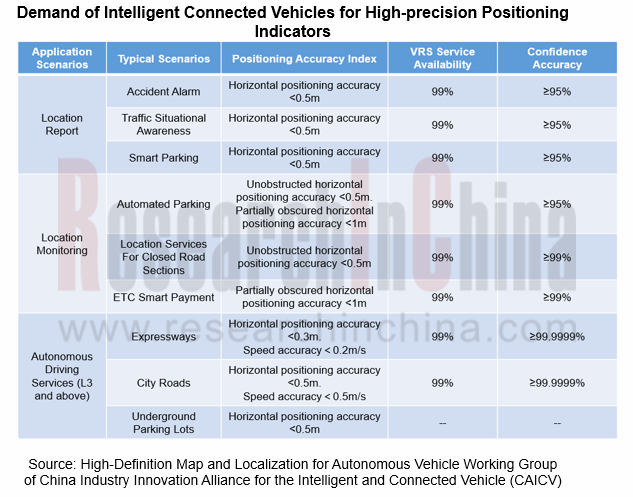
L3 autonomous driving is heading for mass production, and integrated navigation positioning becomes the standard
In March 2021, Honda officially released the L3 autonomous production car, Honda Legend EX (which obtained L3 autonomous driving certification from the Ministry of Land, Infrastructure, Transport and Tourism of Japan) equipped with the Honda SENSING Elite intelligent driving system, high-precision positioning modules, sensors and a 3D HD map.
Honda has produced 100 units of L3 autonomous models, which are leased and sold to users in Japan for three years, allowing users to drive on designated roads in Tokyo.
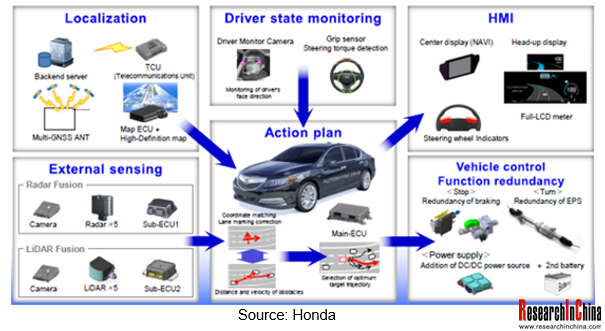
In December 2021, the German Federal Motor Transport Authority (KBA) granted system approval for Mercedes-Benz's L3 autonomous driving system on the basis of the technical approval regulation UN-R157 (UN Regulation No. 157 - Automated Lane Keeping Systems (ALKS)), allowing the sale and driving of L3 autonomous vehicles from a legal level. This is a breakthrough in mass-produced autonomous driving technology.
According to Mercedes-Benz's plan, its two flagship sedans, S-Class and EQS, will be equipped with the L3 autonomous driving system (including a high-precision positioning module + HD map) at first. It is expected that consumers will be able to purchase L3 Mercedes-Benz cars in the first half of 2022. The contracting states of UN-R157 include EU countries, the United Kingdom, Japan, South Korea, Australia, etc., which means that Mercedes-Benz's L3 autonomous vehicles can be sold in these countries.
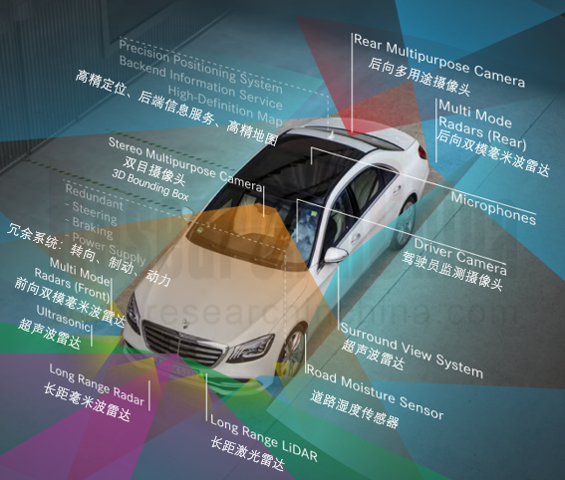
China has not legally allowed L3 autonomous vehicles to be on the road, but L2+ (close to L3) autonomous models have been launched intensively so far. According to the statistics of ResearchInChina, the assembly rate of L2 autonomous passenger vehicles exceeded 20% in China in 2021. Some of the L2 models have achieved high-speed pilot autonomous driving by installing high-precision positioning and HD maps. For example, Xpeng P7, NIO EC6, ES6, ES8, GAC Aion V, Aion LX, Great Wall WEY Mocha and other models can be equipped with optional high-precision positioning modules. FAW Hongqi E-HS9, HiPhi X, 2021 Li ONE and other models are equipped with high-precision positioning modules as standard.
In addition to the existing mass-produced models, OEMs have successively launched more than 10 models equipped with high-precision positioning technology since 2021, such as Xpeng P5, NIO ET7, Neta U Pro, Aion V Plus, Aion LX Plus, Great Wall Mecha Dragon, BAIC ARCFOX αS Hi, etc.
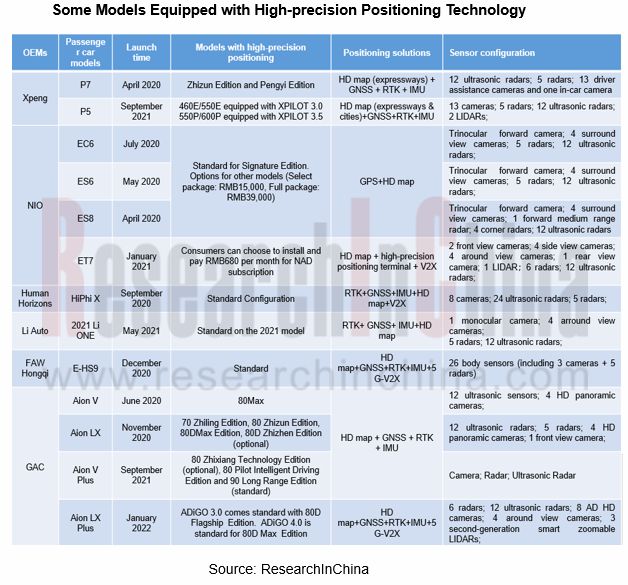
Currently, a single positioning technology cannot meet the high precision required for autonomous vehicles. The solutions used by OEMs basically use multi-sensor integrated positioning technology. In addition to integrated navigation modules and HD maps, technologies such as visual SLAM and Lidar are also used.
Relative positioning cannot be used with standard HD maps, because their coordinate systems, data formats, interfaces, and timelines are completely different. Standard HD maps must be used with absolute positioning. Therefore, the current mainstream positioning technology is that GNSS, IMU, and HD maps cooperate and complement each other to form a high-precision positioning system for autonomous driving.
Baidu: It has been laid out for many years in integrated positioning technology, and can provide self-positioning system and centimeter-level integrated positioning solutions based on GPS, IMU, HD maps and data from multiple sensors.
Baidu Apollo's research and test results show that GNSS-RTK can cover 65% of integrated scenarios with the error of less than 20cm, the combination of GNSS+IMU can cover about 85% of the scenarios, and the high-precision positioning system consisting of GNSS+IMU, sensors and maps can achieve 97.5% coverage.
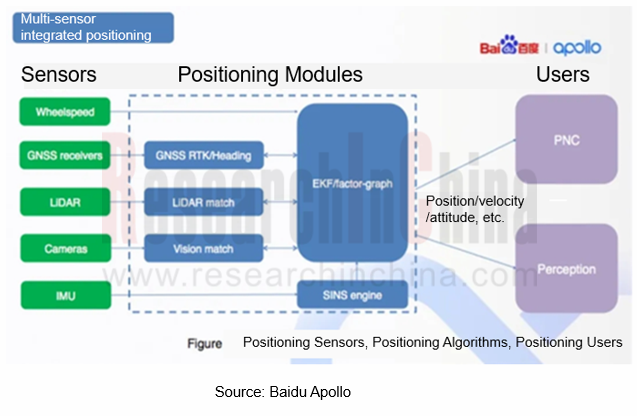
The integration trend of high-precision positioning technology is obvious
(1) Independent positioning box
In terms of product form, the current automotive integrated navigation system with high-precision positioning mainly exists in the form of a positioning terminal, that is, a positioning box (P-Box).

As a small ECU responsible for high-precision positioning, P-Box can provide positioning data to the map module to realize the matching of positioning technology and HD maps.
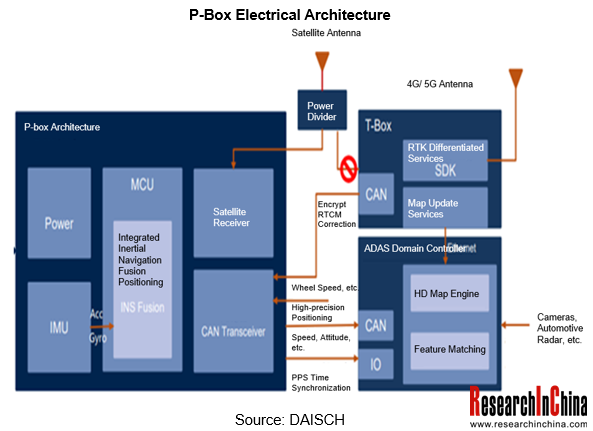
With the advancement of technology, in addition to integrating GNSS and IMU, P-Box will further integrate HD maps. By HD maps and high-precision positioning, more accurate positioning data can be obtained.
Asensing: In April 2021, an HD map box was launched, which integrates IMU, RTK, vehicle speed, ADAS cameras and HD map data. Based on the fusion of MEMS high-precision inertial navigation data and high-precision satellite positioning data, the HD map box adds perception data of ADAS cameras and HD maps to make the lateral error less than 0.2 meters and the longitudinal error less than 2 meters at 95% confidence interval.

(2) Integration with wireless communication modules
The integration of automotive wireless communication modules and GNSS high-precision positioning is becoming a trend. For example, the Hongqi E-HS9 launched at the end of 2020 is equipped with a C-V2X smart antenna developed with Neusoft jointly and integrated with a GNSS receiver; Buick GL8 Avenir, launched at the end of 2020, is equipped with Quectel's AG15 and AG35 modules and GNSS technology.
Joynext: On the basis of the traditional T-Box module, it integrates V2X, Bluetooth key, high-precision positioning and HD map output, providing sub-meter high-precision positioning. Joynext has signed a contract with NIO's 5G-V2X platform project to provide the latter with 5G-TBOX and 5G-VBOX, which will be applied on ET7 at first.
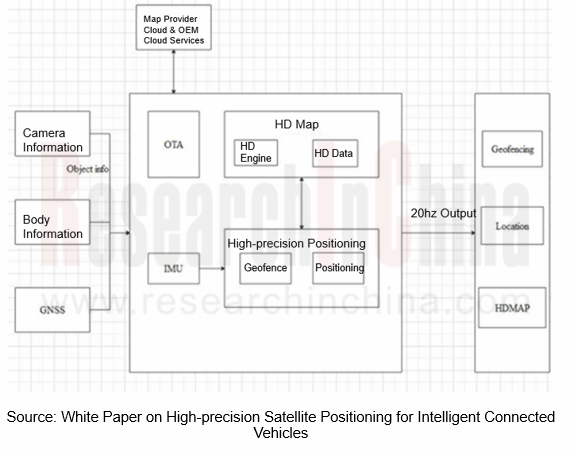
Quectel: It has cooperated with Qualcomm and Qianxun SI to launch a variety of automotive communication modules that support high-precision positioning based on Qualcomm's 3D dead reckoning technology and built-in Qianxun SI's high-precision positioning service. For example, AG55xQ series, the 5G&C-V2X automotive module with built-in multi-constellation GNSS (GPS/GLONASS/BeiDou/Galileo/QZSS) receiver, can support dual-frequency GNSS, high-precision RTK/PPE and GNSS/QDR integrated navigation solutions according to application requirements.
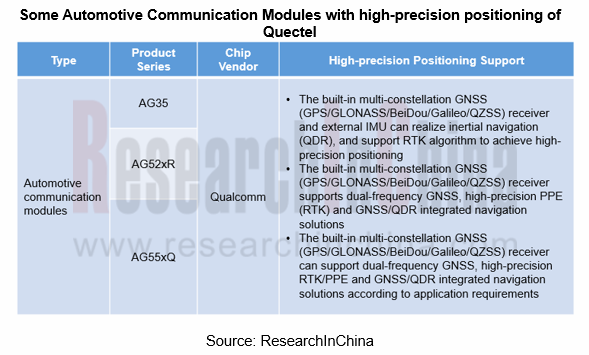
(3) Integration with Autonomous Driving Domain Controllers
Integrating the high-precision positioning module into the autonomous driving domain controller can reduce data transmission, effectively shorten information delay, and improve positioning accuracy. At present, automakers have begun to disassemble integrated navigation boxes and integrate GNSS modules and IMU modules into their own domain controllers.
At present, passenger cars basically use sub-meter-level integrated positioning modules, which have a low level of functional safety and are not necessary to integrate into domain controllers. When autonomous driving evolves to L3+, L4/L5, high-precision integrated positioning modules must reach the centimeter level, and meet higher functional safety requirements, so that they can be integrated into autonomous driving domain controllers. By then, the value of the integrated navigation and positioning module of each vehicle will be higher, which will also be the priority of major OEMs and suppliers in the next stage.
With the maturity of domain controller technology and the evolution of electronic and electrical architecture, the integration of high-precision positioning units and high-level autonomous driving domain controllers may become one of the mainstream solutions.
The prospect of high-precision positioning market is promising
According to Intelligent Connected Vehicle Technology Roadmap 2.0 released in November 2020, the penetration rate of L2-L3 ICVs will reach 50% by 2025, and L4 ICVs will begin to enter the market and be available in certain scenarios and limited areas for commercial applications; by 2030, the penetration rate of L2-L3 ICVs will reach 70%, and L4 ICVs will be widely seen on expressways and some urban roads.
Supported by policies, the assembly rate of L2 autonomous vehicles will continue to grow, and the assembly rate of sub-meter-level integrated positioning modules will keep rising; L3 and L4 autonomous vehicles will gradually spread to the market, and the shipments of centimeter-level integrated positioning modules with higher value will swell. Therefore, it can be predicted that the market space for high-precision positioning in the next few years is very broad.

With the increase in the assembly rate of L2+ and L3 autonomous driving functions, the high-precision positioning market has a promising prospect, and the industry will be recognized by investors.
In October 2021, Asensing raised hundreds of millions of RMB in Series C financing led by Sequoia China and joined by Matrix Partners, GL Ventures and other institutions. The funds will be spent on the research and development of the next-generation functional safety high-precision positioning technology, product design improvement and capacity construction.
In October 2021, DAISCH completed the Pre-A round of financing, which was involved with Aosheng Capital. The raised funds will be invested in developing new products and processes, and improving delivery capabilities.
Automotive High-precision Positioning Research Report, 2022 by ResearchInChina highlights the following:
 Classification, technical challenges, industrial policies, market size, corporate structure, development trends, etc. of high-precision positioning technology;
Classification, technical challenges, industrial policies, market size, corporate structure, development trends, etc. of high-precision positioning technology;
 Application scenarios and market forecasts for autonomous driving positioning, including autonomous passenger car positioning solutions and market forecasts, low-speed autonomous driving high-precision positioning solutions and market forecasts, autonomous special vehicle positioning solutions and market forecasts, etc.;
Application scenarios and market forecasts for autonomous driving positioning, including autonomous passenger car positioning solutions and market forecasts, low-speed autonomous driving high-precision positioning solutions and market forecasts, autonomous special vehicle positioning solutions and market forecasts, etc.;
 Development of signal-based positioning technology, signal-based positioning solutions of major suppliers;
Development of signal-based positioning technology, signal-based positioning solutions of major suppliers;
 Industrial pattern of inertial navigation positioning, positioning products and positioning solutions of major inertial positioning technology suppliers;
Industrial pattern of inertial navigation positioning, positioning products and positioning solutions of major inertial positioning technology suppliers;
 Status quo of integrated navigation technology, supplier structure, positioning solutions of major integrated positioning technology suppliers;
Status quo of integrated navigation technology, supplier structure, positioning solutions of major integrated positioning technology suppliers;
 Main products, main technologies, development trends of basic positioning technology suppliers.
Main products, main technologies, development trends of basic positioning technology suppliers.
Automotive CMOS Image Sensor (CIS) Chip Industry Research Report, 2022
Automotive CIS research: three major segmentation scenarios create huge market space
It is known that the biggest application market of image sensor is smartphone field. As the smartphone market beco...
Global and China Automotive Cluster and Center Console Industry Report, 2022
Automotive Display Research: Penetration Rate of OLED, Mini LED and Other Innovative Display Technology Increased Rapidly
With the penetration of new energy and intelligent driving vehicles, the tren...
Autonomous Driving Simulation Industry Chain Report (Chinese Companies), 2022
Simulation Research (Part II): digital twin, cloud computing, and data closed-loop improve simulation test efficiency.
Simulation tests can not only be conducted in extreme working conditions and mor...
Automotive Memory Chip Industry Research Report, 2022
Automotive Memory Chip Research: Localization is imperative amid intense competition
The global smart phone storage market size hit US$46 billion in 2021 when the global automotive storage market siz...
Autonomous Driving Simulation Industry Chain Report (Foreign Companies), 2022
Simulation test research: foreign autonomous driving simulation companies forge ahead steadily with localization services.
As the functions of ADAS and autonomous driving systems are developed and th...
China Automotive Multimodal Interaction Development Research Report, 2022
Multimodal interaction research: more hardware entered the interaction, immersive cockpit experience is continuously enhanced
ResearchInChina's “China Automotive Multimodal Interaction Development Re...
Global and China Automotive Operating System (OS) Industry Report,2022
Operating system research: the automotive operating system for software and hardware cooperation enters the fast lane.
Basic operating system: foreign providers refine and burnish functions; Chinese ...
Automotive Millimeter-wave (MMW) Radar Industry Report, 2022
Automotive radar research: installations surged by 49.5% year on year in 2021, and by 35.4% in the first nine months of 2022.
1. The installations of automotive radars sustain growth, and are expect...
Automotive DMS/OMS (Driver/Occupant Monitoring System) Research Report, 2022
In-cabin Monitoring Research: In the first nine months of 2022, the installations of DMS+OMS swelled by 130% yr-on-yr with visual DMS/OMS as the mainstream solution
Local manufacturers are keen to de...
NIO ET5/ET7 Intelligent Function Deconstructive Analysis Report, 2022
NIO ET5/ET7 Intelligent Function Deconstruction: R&D will change the market pattern in 2025Chinese automakers have triumphed remarkably in the field of high-end intelligent electric vehicles. Afte...
Automotive Smart Cockpit Design Trend Report, 2022
Research on design trends of intelligent cockpits: explore 3D, integrated interaction. ...
Commercial Vehicle Telematics Report, 2022
Commercial vehicle telematics research: three parties make efforts to facilitate the industrial upgrade of commercial vehicle telematics.
In 2022, China's commercial vehicle telematics industry cont...
Passenger Car Intelligent Steering Industry Research Report, 2022
Research on intelligent steering of passenger cars: The development of intelligent steering is accelerating, and it will be put on vehicles in batches in 2023
In September 2022, Geely and Hella joi...
China Charging / Battery Swapping Infrastructure Market Research Report, 2022
Research of charging / battery swapping: More than 20 OEMs layout charging business, new charging station construction accelerated
From January to September 2022, the sales volume of new energy vehic...
China L2 and L2+ Autonomous Passenger Car Research Report, 2022
L2 and L2+ research: The installation rate of L2 and L2+ is expected to exceed 50% in 2025.So far, L2 ADAS has achieved mass production, and L2+ ADAS has seen development opportunities as the layout f...
Global and China L4 Autonomous Driving and Start-ups Report, 2022
L4 autonomous driving research: the industry enters a new development phase, "dimension reduction + cost reduction".
L3/L4 autonomous driving enjoys much greater policy support.
...
Software-defined vehicle Research Report 2022- Architecture Trends and Industry Panorama
Software-defined vehicle research: 40 arenas, hundreds of suppliers, and rapidly-improved software autonomyThe overall architecture of software-defined vehicles can be divided into four layers: (1) Th...
Emerging Automaker Strategy Research Report, 2022 - Li Auto
Research on Emerging Automaker Strategy: the strategic layout of Li Auto in electric vehicles, cockpits and autonomous driving
Li Auto will shift from the single extended-range route to the “extended...